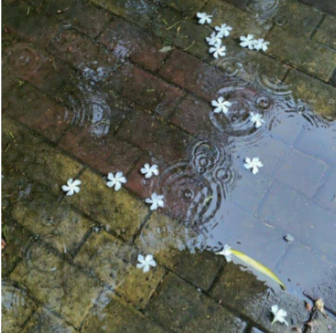What To Do With An Empty Notebook
- Kiara Aggarwal
- Apr 1
- 5 min read
By Alin Sengjaroen
Ever since elementary school, every time I stumbled into 7-11, feeling the cold rub against
my sweaty back, I’d always walk out into the sun with a shield – a new notebook. And for
every inch of my house, there is at least one unused notebook, trapping dust and childhood
memories locked inside.
To those who declare themselves a notebook addict & to my smaller self…
What the hell will I do with these now?

I. Commonplace books
As the name suggests, these books archive quotes, ideas, poems, and anything in between. They’re a resting place for your thoughts that you may return to visit in the future. Simply, those things you write in your notes app past 9 PM can be put into these notebooks!
If you’ve tried keeping a journal or diary before but failed miserably, this might be the one
for you. You don’t need to write something down every day or make aesthetic sheets to fill
out every month. Just write. Whenever you feel like it.
The way you organize ideas varies. Most don’t have a system, but some do. If you’re a super neat person, an index notebook or index cards can help separate categories. You may also indicate each category with a symbol at the top edge of the page, then write out a table of contents.
Remember that commonplace books are not meant to look pretty; they’re just meant to be a space for the things you love. Pen them as artists would sketch and as musicians would demo.

II. Scrapbook / Junk journal
This is best suited for people who have hoarding tendencies and/or those who go out often (and also for those who want to try out those aesthetic journal pages but are unable to either because of the costs of stickers or environmental concerns). As a kid, I’d always have a box of junk collections such as receipts, candy wraps, etc., and it would get incredibly messy until I slap them all on a page.
All you have to do is gather the ‘trash’ you’d like to keep, which turns them into treasures. It
can be anything that you deem as beautiful or remarkable. Then, paste them in the journal as you would do with decorations. Keep in mind that the journal may get chunky, and it’s
advised to find a strap to close the notebook when it gets thick (unless it already comes with a strap).

III. Daily diary
This is probably the most common way to use an empty notebook. We’ve all had a diary
when we were younger at one point, but growing up, most of us don’t write them anymore. If I had to guess, the main reasons would probably be privacy concerns and just the fact that we don’t have as much time as we used to; however, as harsh as it may sound, the second reason is not true in most circumstances. To be concise, the problem is not the lack of time but rather the lack of discipline.
Writing a diary entry takes 5-10 minutes. It’s the consistency that becomes hard. Someday
you will forget, then give up this resolution of writing a diary every day for 20XX. It’s OK to
forget, and it’s OK to skip certain uneventful days. Although there is advice out there that has stuck with me since the start of my diary journey… The more you write diary entries, the more you’ll be able to see the interesting things in uneventful days. You don’t need to go out and be on an adventure for the day to be fulfilling. Some days I’d write about how I petted a siamese cat in my neighborhood or that I tried cooking a new dish. It challenges you to make the day interesting by looking closer instead of further.
Usually, diaries go on sale at the end of the year, but you’re not obligated to start a diary at the beginning of the New Year. You can just start now. Besides that, you can also use several thinner notebooks and separate them into the first and second half of the year or by quarters. I also like to junk-journal in my diary at the same time if you have the space to.
Additionally, you do not need to make your diary beautiful. It is meant for you to process the day, record what you want to remember, and learn more about yourself – not for the sake of aestheticism.

IV. Bullet journal
You’ve probably seen bullet journals circling social media before – those water or habit
trackers organized in beautiful charts. They are usually used to track anything you want to,
such as water intake, films you’ve watched, books you’ve read, to-do lists, weekly plans, etc.
Most of the time, dotted notebooks are used for the sake of writing lists. Most prefer to
decorate them with stickers and highlighters too, but as usual, don’t feel obligated to do so – you’ll only burn yourself out.

V. Morning Pages
Similar to free-writing, you write whatever comes to mind the moment you wake up, even if
you may be drowsy (it’s recommended to write at least 3 pages or more). Morning pages help with regulating emotions, clearing anxiety & brainstorming ideas, especially for literary works.
These writings aren’t supposed to be perfect – they just have to BE. It doesn’t have to make
sense, either. Whatever crosses your mind should be put down on the paper for the next three pages, then repeated tomorrow. Some people use prompts, some don’t. It’s up to you. Although I do recommend writing prompts before you sleep, so you can immediately start writing when you wake up rather than spend half an hour trying to find a perfect prompt.
Any notebook may work. A lined one would be preferable so you may be able to write
clearer.

VI. Dream Diary
As the name suggests, you write down your dreams (or nightmares) the moment you wake
up. Usually, people forget what they dreamt of five minutes after waking up, so you would
need to write immediately once you open your eyes.
Typically, I prefer to only write peculiar dreams and jot them down on my notes app as it’s
faster than physically writing.
By doing this, you can recognize the pattern of your dreams or nightmares. The recurring
themes, the frequent settings – the absurdity becomes comprehensible and that may ease the anxiousness in you, especially if you have frequent nightmares.

TO CONCLUDE…
As the years go by, environmental concerns worsen, so I advise you to use what you have
instead of buying new notebooks entirely. Go into your storage room, dig into the boxes, and rediscover what you once had; you may be able to find something completely unused. Even so, when buying, please make sure to buy notebooks made from recycled papers. Although they may be a little more expensive, the Earth is worth more than any amount of bank note.



Comments